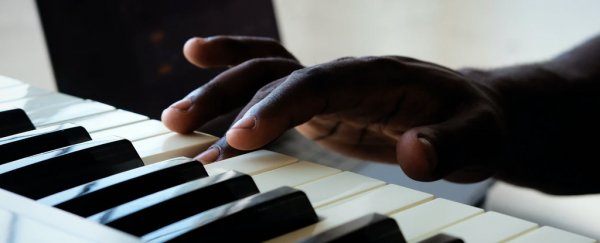If you sit down at a piano, hitting different notes with each hand would be the first step to mastering the instrument. But what if both hands are intent on doing the same thing? That's the experience of people with a rare condition known as mirror movement, and doctors have now documented a unique case.
Several years ago, researchers in India identified a case of this extremely rare condition in a 13-year-old girl who also has a diagnosis of the chromosomal disorder Turner syndrome.
Finding the two conditions together is a first for the medical community, raising questions of how – or even whether – the two might potentially be connected.
Most tiny humans take a while to become dextrous, but by age 10 the communication between the two halves of our brain allows us to pinch, poke, wave and wiggle the fingers on each hand independently of one another.
For about one in every million children, this development is incomplete, meaning one hand's actions are echoed simultaneously by the other. Make a victory sign with your left hand, and your right will be forced to approximate a similar shape.
The fundamental cause of such copy-cat movement is still largely a matter of speculation, though there's reason to suspect key nerves in the brain are 'cross-talking' as a result of the formation of false synapses between neurons.
In about a third of all cases, mutations in a couple of genes appear to be responsible, impairing development of the nervous system in such a way that instructions from either side of the brain are accidentally transmitted to both sides of the body.
As for the rest of recorded cases, clearly there's still much to learn about the brain and its development.
One place we can look for more clues is in other symptoms and behaviours exhibited by those with the condition and ask if there is a deeper relationship.
For example, individuals who also have cerebral palsy will display degrees of mirror movements. Parkinson's disease is another condition that can come with this form of so-called synkinesia, especially if it affects more one side of the brain than the other.
Having breaks or an absence of connection between the hemispheres – a bridge of neurons called the corpus callosum – can also coincide with the behaviour. It's in many of these cases that a genetic link has been uncovered.
Kallmann syndrome is a condition caused by lack of certain hormones, giving rise to characteristics such as a lack of smell and delayed puberty. And, sometimes, mirror movements.
Turner syndrome is also a condition that impacts on a body's ability to coordinate hormonal responses.
Before this case, nobody had recorded a person who had the chromosomal abnormality and would experience mirror movements as well.
The syndrome is caused by an absence of a second X chromosome, leaving those with the disorder with just a single X to do the job. The consequences can be widespread across the body, ranging from heart defects to reduced height, and a failure in ovary development.
In the case of this particular young subject, there were some mild physical abnormalities, and an absence of secondary sexual characteristics. An echocardiogram of her heart revealed an aortic valve with two instead of the usual three flaps, but otherwise all appeared healthy.
Besides poor school work, her speech and other neurological signs were all as expected for a kid her age. Yet as you can see below, given a task of counting to five on her left hand, her right hand just couldn't help but join in.

An MRI scan didn't reveal any surprises, and without the resources to look closer at her brain's physiology, the medical staff at Sri Ramachandra Institute of Higher Education and Research were left to assume it's 'just one of those things'.
As mirror movements are incredibly rare, and Turner syndrome affects just one in 2,000 women, it's hard to say if it's a coincidence or if there's some kind of connection that might tell us more about both conditions. Medical science is often a matter of recording novel discoveries like these and waiting patiently to see if future findings add increments of evidence.
As for the young lady, who's now 19, we're happy to say the subject of this unusual case study appears to otherwise be doing well.
"Considering her age, she was started on gradually escalating doses of oestrogen followed by progesterone therapy," the endocrinologists write.
This case study was published in BMJ Case Reports.
